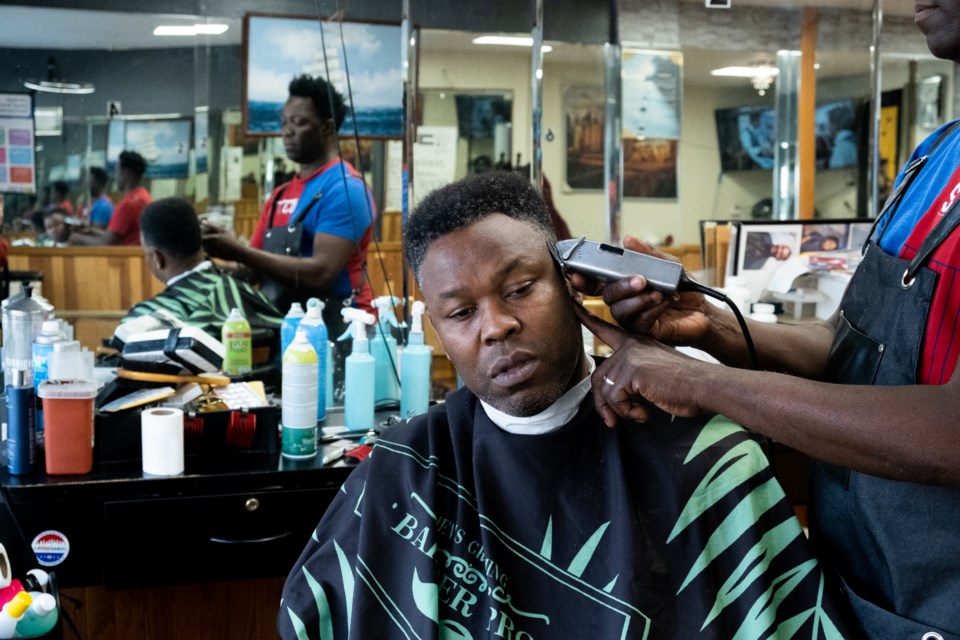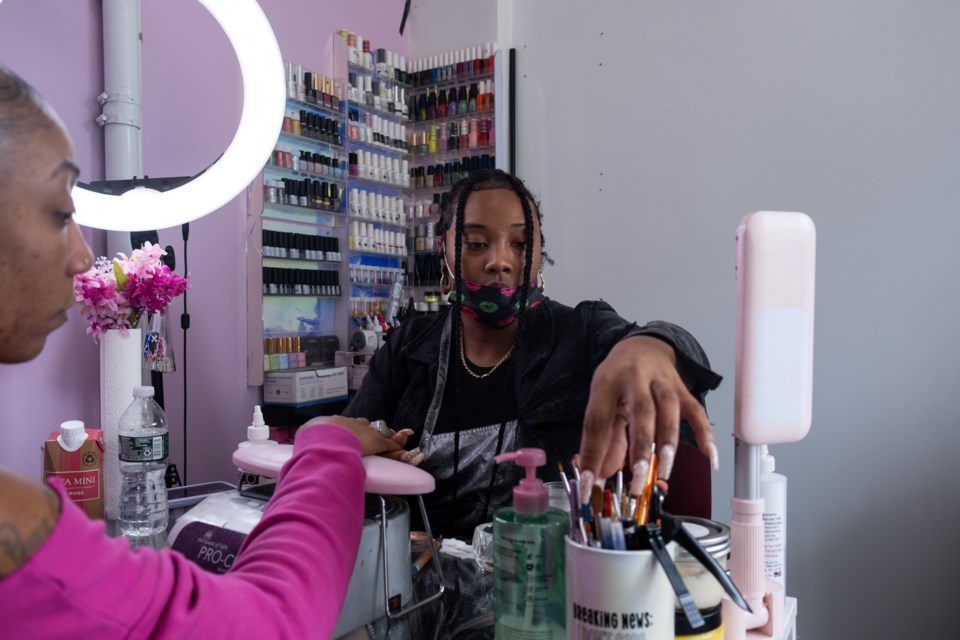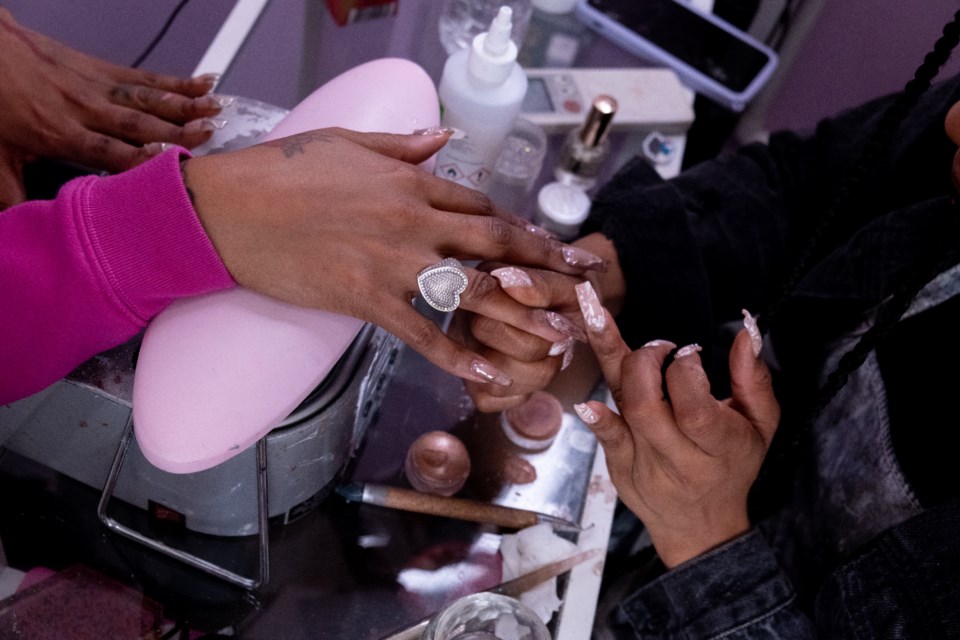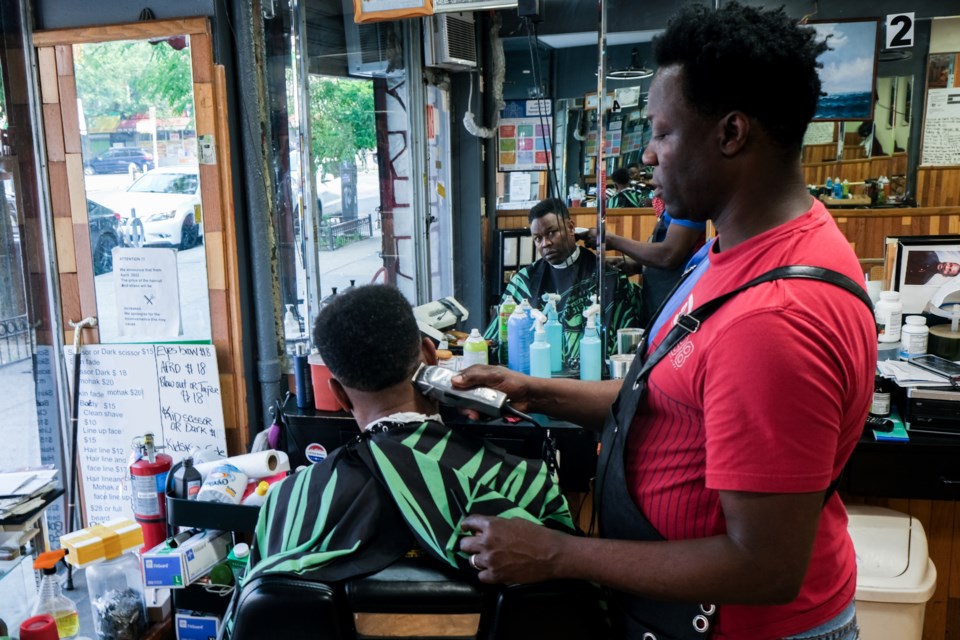On a recent afternoon at a salon in the Brooklyn neighborhood of Flatbush, where beauty parlors are sometimes three-to-a-block, an inconvenienced hairdresser had little to say about business other than, “It’s not good.”
Up and down nearby streets, as Black hair stylists deftly twisted in hair extensions, squeezed lines of glue onto tracks and wielded buzzing razors, the responses were much the same: The beauty industry here has not fully recovered from the economic aftermath of the pandemic.
“Since COVID, everything’s changed completely,” said barber Patrick Goby, who has owned Goby’s Barber Shop on Nostrand Ave. for more than a decade. “Everything.”
Hairdressers were not considered essential in 2020 and therefore not allowed to continue working through the lockdown.
As time wore on, the profession became symbolic of the pandemic’s impact on personal care: People who had previously kept tight lines started growing their hair out; beauty professionals pivoted to become YouTube gurus; and stylists risked their personal safety to make house calls during peak infection periods.
In 2021, the Professional Beauty Association surveyed 2,532 salons and spas, who said that out of more than two million clients services after re-opening, just 0.07% reported testing positive for COVID-19 within 14 days of their visit.
Even with the low risks associated with beauty services, the intimate contact required between client and technician made it one of the first most obvious places to avoid during the pandemic.
Flatbush — a section of Brooklyn The New York Times once called a “veritable mecca of beauty” — is symbolic of that impact. Since the community is largely Caribbean and hair salons have typically been necessary for maintaining protective styles like braids, locs and twists, the neighborhood is dense with barbershops, salons and beauty supply stores.
Of the 13 beauty industry workers BK Reader spoke with in Flatbush— including hair stylists, barbers, nail techs and beauty supply merchants — not a single person said they have rebounded to pre-pandemic levels of business.
Many said customers are coming less often after figuring out how to do their own hair online.
“[Former clients are] going on YouTube now and doing some stuff for themselves, because the time is really rough and they can’t cover all the bills,” said Zina Cherif, a hairdresser who rents a chair at a salon on Clarendon Ave. “They’re using the money they were using for braids to go get some food.”
They also report battling rent increases and inflation, which has in some cases forced price hikes.
The Cost of Doing Business
Patrick Goby took a short break between haircuts one Tuesday afternoon, still wearing his apron as he leaned against the back of a bench in his barbershop.
Goby, who is originally from Haiti, has been cutting hair in the neighborhood for 22 years. It’s a profession that requires discipline, he said, so he works seven days a week from 9:00am to 8:00pm. But when he had to close up shop during the pandemic, he only cut hair for friends and family, who paid extra to help him stay afloat.

Like many small business owners, Goby was not able to take out a PPP loan because he doesn’t have regular employees. The barber who rents a chair in his shop doesn’t count.
“As a taxpayer, they gave me a stimulus, like everybody,” he said. “I didn’t use it to feed myself… I used that money to pay the rent.”
In response to the specific economic deficits faced by beauty industry workers, organizations like the Professional Beauty Association ran fundraising efforts to buoy beauty professionals through the worst of the pandemic. The association raised $1.64 million in total, which it gave to nearly 3,300 beauty professionals.
But as restrictions lifted — albeit slowly, at first — small business owners in the industry faced more hurdles on their own, namely rent and supply price hikes.
When Goby first moved into his shop in 2007, it cost $900. Today he pays $1,700. He would be considered lucky — another Flatbush salon owner, Maria Butrous of Maria’s Beauty Parlor III, said she was priced out of her salon during the pandemic and has had to move to a smaller location.
At the same time, the cost of supplies has spiked, forcing beauty industry workers to pass some of the costs onto their already stretched clientele.
David Hong, the owner of Metro Beauty Supply on Flatbush Ave., said “business has been terrible” thanks to increased prices and tough economic conditions.
Janney McKoy, a barber who rents a chair at New Visionz Unisex Salon on Clarendon Ave., said he’s now paying $22 for razor blades that used to cost $15.
Lavish Testman, who owns a nail and beauty parlor on Cortelyou Ave., was paying around $130 for a gallon of high-quality acrylic liquid — also called monomer — on a popular beauty supply site pre-2020. Now that same liquid costs $239.
“You’re kind of stuck between a rock and a hard place, because inflation makes me have to raise the price a little bit, but then if I raise the price a little bit, I scare clients away,” Testman said.

Nearly every hairdresser said they're seeing more DIY cuts and styles now than ever. Darline Casseus, who owns All About You Salon/DBA AAY Braiding Salon on Flatbush Ave. said she’s fed up with clients who come in with at-home hair malfunctions. She sometimes refuses to fix mistakes or charges extra: “You knew we were here before you messed up your hair,” she said. "So I feel some type of way about that.”
To make up for the slow period, Casseus has been buying ads on Google and Yelp. Google seems to be helpful in bringing in more customers, she said, but it’s costing her “a lot of money.”
While many of these beauty care workers are optimistic about the future, a few said they’re thinking of getting out of the industry. Ellie Drake has been doing hair for 25 years, but she’s now considering training to become a home health aide.
“I’m thinking of doing the hair on the side,” she said.
Forging Ahead
Lavish Testman sat at a small table in her purple-toned shop on Cortelyou Rd. in early June, placing her client’s fingertips between cap clips soaked with acrylic remover, her own flowery nails clicking against the plastic as she worked.
Testman, 31, has been doing hair and makeup since high school. She got her professional license around 2011. In 2020, she was renting a booth and, for the first time, seeing a steady stream of her own clients. Then the pandemic hit.
“I was so, so upset,” she said.
Testman has PCOS, a hormonal disorder that makes her immune system sensitive, so even when she was offered $300 to make a house call during the lockdown, she declined.

In 2021, however, she became one of nearly 5.4 million Americans emboldened to open their own business.
Because many nail techs already practice medical-grade sanitizing, she said it wasn’t that hard to manage COVID-related health requirements.
What has been tough, however, Testman said, is running a small business for the first time. She used her own savings to open the shop without loans.
“I wish there was more education out there in the community for us,” she said. “I’m educated in my field, in my industry,” but as far as entrepreneurism, she said, “I’m winging this whole thing.”
Dominique Coad, while getting her nails done by Testman, said she won’t be among the clients tackling professional beauty services themselves.
“I’m a mother of three,” Coad said. “So that would mean I need to come and let somebody else pamper me-- even if I can do it myself, because I’m already doing everything for me and my kids.”
Surviving 2020 with three kids at home was stressful, she added: “I needed this and still need it.”
Clearly, for some who enjoy the benefits of beauty services, taking "me time" is a non-negotiable part of life; something you can't afford to not do for your mental health.
Whatever happens, Goby said, he won’t be leaving his barbershop anytime soon.
“I’m not worrying,” he said. “If everybody else will fall, I think I will be the last.”



.png;w=120;h=80;mode=crop)
